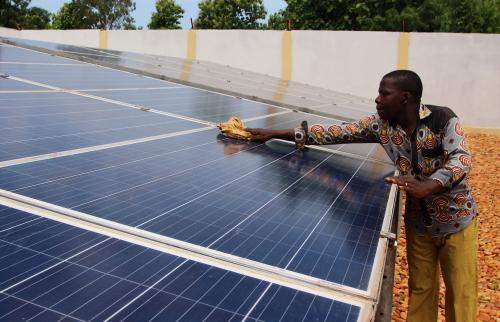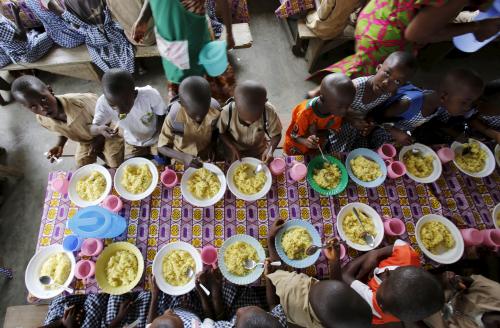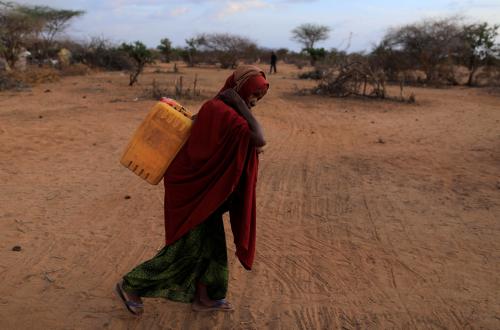The ambitious Sustainable Development Goals (SDGs) and Africa’s Agenda 2063 are now well underway. Notably, though, policymakers and other stakeholders often encounter challenges when trying to measure countries’ progress towards these aims—particularly when it comes to data. The SDGs contain 232 indicators that measure countries’ performance towards the 17 goals, but 62 percent of them are not trackable in Africa due to severe data limitations according to the report, “2017 Africa Sustainable Development Report: Tracking Progress on Agenda 2063 and the Sustainable Development Goals.” This report, by the United Nations Economic Commission for Africa (UNECA), in collaboration with the African Development Bank, the African Union, and the United Nations Development Program (UNDP), explores the progress that the continent has made towards the SDGs while also identifying the data gaps facing policymakers and implementers. On a positive note: In many areas, especially in health, where data is more available, Africa is making progress.
Poor data availability challenges tracking progress on SGDs and Agenda 2063
The report largely attributes the poor availability of data to inefficiencies at the local statistics collecting agencies. According to the report, only 12 of Africa’s 54 countries have autonomous statistics offices. In addition, Africa’s national statistics offices have often been marred by insufficient funding and a lack of autonomy. Data quality is another challenge, according to the report, due to differences in methodologies and a lack of coordination across national statistics systems.
As seen in Table 1, indicators under certain goals are easier to track than others. For instance, Goal 3—Ensure healthy lives and promote well-being for all at all ages—is the most trackable with 69 percent of indicators having available data. Conversely, there is no data available to track Goal 13—Take urgent action to combat climate change and its impacts. Indicators under this goal include the number of human casualties directly tied to disasters and the proportion of local government that adopt local disaster risk strategies.
Table 1. Sustainable Development Goal data availability on African countries
 Source: 2017 Africa Sustainable Development Report: Tracking Progress on Agenda 2063 and the Sustainable Development Goals.
Source: 2017 Africa Sustainable Development Report: Tracking Progress on Agenda 2063 and the Sustainable Development Goals.
Africa made noticeable progress on health indicators during the Millennium Development Goal era
As noted above, SDG Goal 3—which is fully aligned with Agenda 2063 targets on child mortality, incidence of TB and HIV, access to maternal health care, among others—has a relatively large share of trackable indicators. Africa has been performing well: For example, over the last 15 years, given that the data is available, we can see that the progress toward reducing child mortality has been faster in Africa than in any other region, as under-five mortality dropped by 46 percent between 2000 and 2015 (Figure 1).
Figure 1. Under-five mortality rate by region
 Source: 2017 Africa Sustainable Development Report: Tracking Progress on Agenda 2063 and the Sustainable Development Goals.
Source: 2017 Africa Sustainable Development Report: Tracking Progress on Agenda 2063 and the Sustainable Development Goals.
Importantly, the availability of data also allows policymakers to pinpoint areas for improvement. For example, often a reduction in child mortality can be attributed to improved maternal health, in which Africa has done well. Another key determining factor is the presence of skilled health professional during birth. According to the data, while progress has been made in increasing the share of births attended by skilled health personnel in Africa, there remains room for progress (Figure 2). With this information, policymakers are alerted to areas for intervention.
Figure 2. Proportion of births attended by a skilled health professional
 Source: 2017 Africa Sustainable Development Report: Tracking Progress on Agenda 2063 and the Sustainable Development Goals.
Source: 2017 Africa Sustainable Development Report: Tracking Progress on Agenda 2063 and the Sustainable Development Goals.
In conclusion, tracking the progress toward the SDGs and Agenda 2063 remains a challenge in face of data limitation. Nevertheless, in cases where data is available, we note that notable progress is being made, such as in child mortality, and can identify specific gaps to make a country’s progress towards achieving the SDGs even more successful.







Commentary
Figure of the week: Africa’s progress on the SDGs and Agenda 2063
November 16, 2017